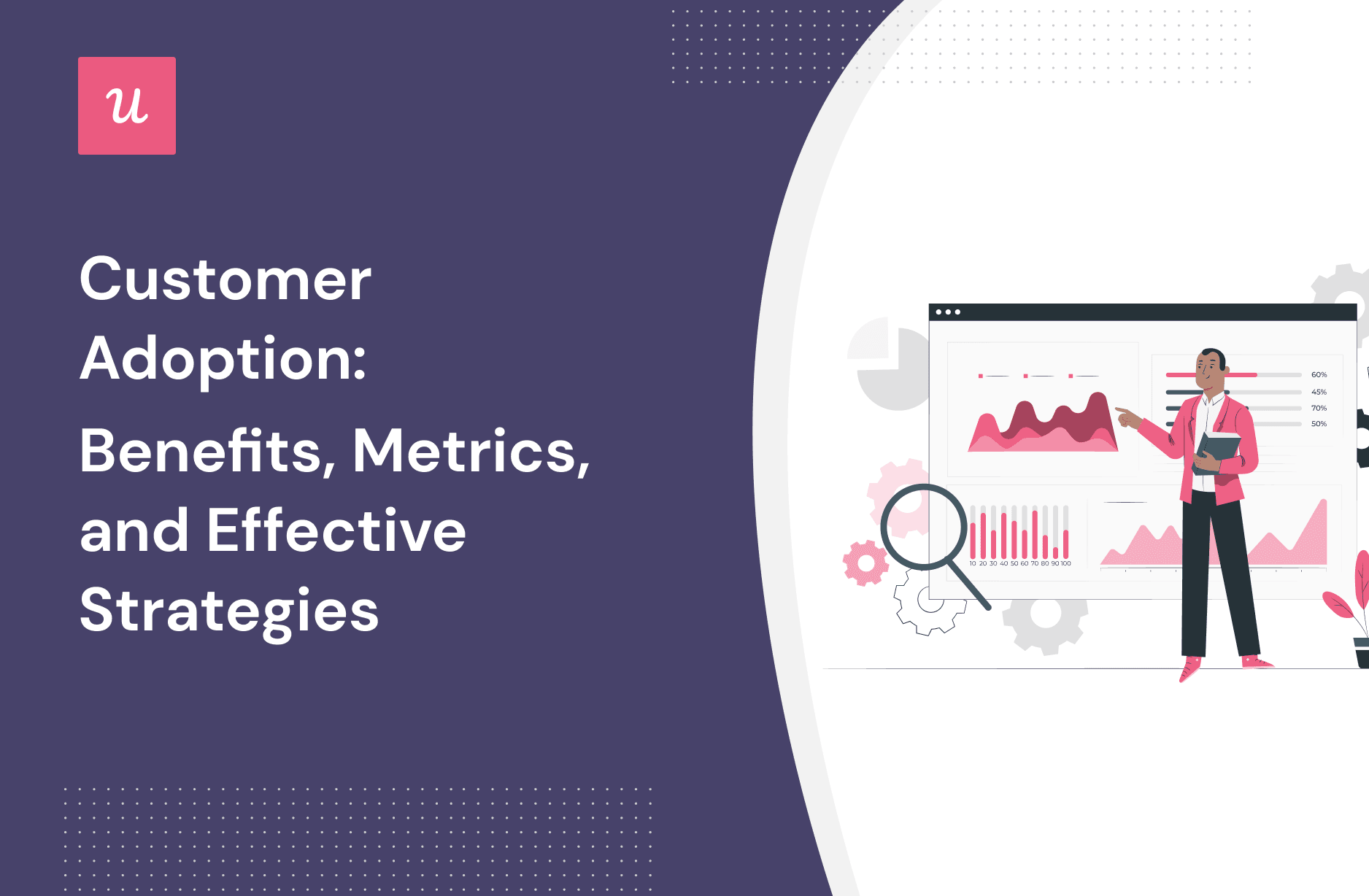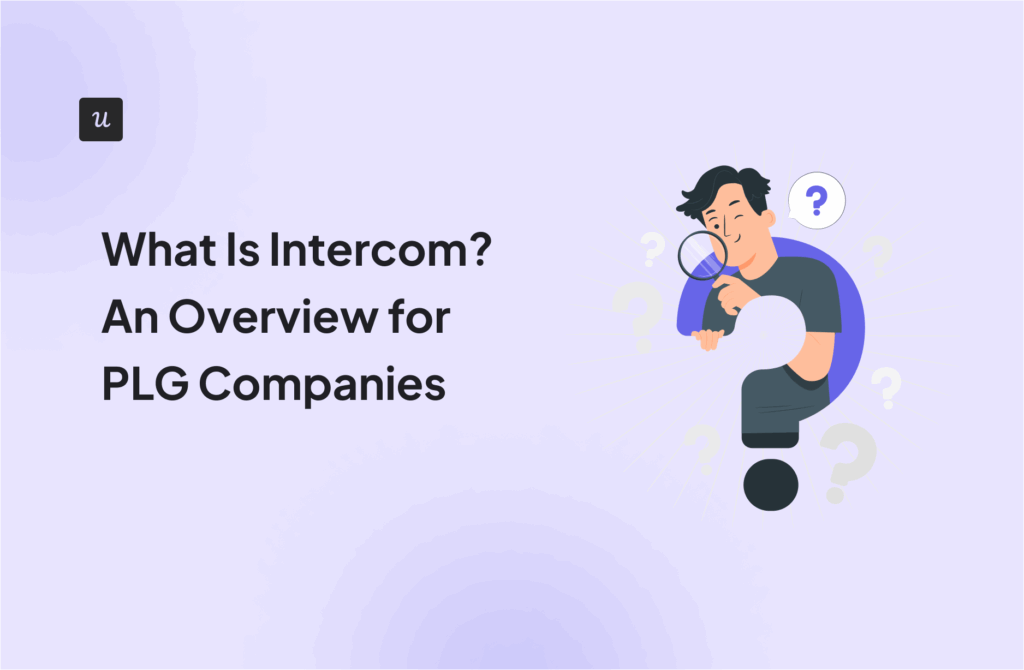
How do you increase customer adoption to grow your product?
In this article, we cover the benefits of increasing adoption and the metrics you should be tracking. Plus, learn the proven strategies that help SaaS companies increase their customer adoption rates.
Try Userpilot Now
See Why 1,000+ Teams Choose Userpilot

What is customer adoption?
Customer adoption is a continuous process where customers learn to use a product, experience value, and build a habit around using it.
Customer adoption vs user adoption
The difference between customer adoption and user adoption lies in who you’re referring to. SaaS users are individual users, and customers are accounts. More specifically, one account (the customer) can have different users sharing the account with different needs.
Why is customer adoption important?
Customer adoption is important because:
- It boosts user engagement. A successful customer adoption strategy keeps customers engaged. When they’re using your product to its fullest potential, they feel motivated to keep using it.
- It prevents churn. Adoption prevents churn because customers who experience constant value are less likely to want to leave. It drives product growth.
As the customer adoption rate goes up, so does product growth. It contributes to more upsells, cross-sells, and higher retention.
5 Stages of the customer adoption curve
There are five stages to the customer adoption curve (aka Innovation Adoption Lifecycle) that describe how willing customers are to adopt new products or changes. They include innovators, early adopters, early majority, late majority, and laggards.
- Innovators: Innovators are willing to try new products. They’re open-minded, excited to test out changes, have high-risk tolerance, and don’t mind minor bugs.
- Early adopters: Early adopters are open-minded and willing to try new products. However, they are more cautious than innovators. They have reservations about new changes.
- Early majority: The early majority group is generally positive about change and trying new products. However, they tend to be cautious and selective about what they actually use. They want to use a proven product.
- Late majority: The late majority are more cautious about trying new products. They tend to wait until a product has a proven track record with many people before they adopt the changes. They’re mindful of bugs and have high expectations.
- Laggards: Laggards are reluctant to change unless they absolutely have to adopt them. Also, they have low-risk tolerance and are mostly unwilling to change their ways.

6 stages of a customer adoption process
The customer adoption process happens in six stages. It starts with awareness and then moves into interest and evaluation. From there, users sign up for the product in the trial stage and reach activation. Then keep using the product as adoption grows.
Let’s explore each stage in more detail:
- Awareness stage: This is the first stage in the adoption process when users first become aware of the product’s existence and what it does.
- Interest stage: In the next stage, users have a growing interest in the product. They may seek more information on how it can help them achieve their goals or solve their problems.
- Evaluation stage: At this stage, they consider the pros and cons of your product while exploring alternative solutions.
- Trial stage: This is when users enter the trial stage. New customers start the onboarding process and explore how your product can help them.
- Activation stage: At this stage, users start to experience the product’s value after completing the essential steps in onboarding.
- Adoption stage: In the product adoption stage, users adopt high-value features and keep using them.

Effective customer adoption strategies to increase adoption rate
To increase your customer adoption rate, it’s crucial to start as early as users sign up. To begin with, you can gather customer data during the signup process to personalize adoption strategies.
After onboarding, you continue to increase the customer adoption rate with ongoing strategies that reduce friction and improve the customer experience.
Here are 9 adoption strategies that work for SaaS businesses:
Create a frictionless signup flow for easy trial signup
A friction-free sign-up process can decrease user abandonment and increase the chances of them becoming active and engaged users.
To keep it simple and free of any unnecessary friction, only ask for the necessary information you need to get started.
For example, monday.com asks new users to provide just their work email address to sign up, or alternatively, they can use Google SSO.

Personalize the customer onboarding journey
Tailor the onboarding experience so customers learn about the most relevant features for their needs.
Use the welcome screen to segment customers based on their shared characteristics, such as their use cases, role, or jobs to be done. Then trigger a personalized onboarding flow for each segment.

By addressing their specific pain points and providing the most relevant features, customers are more likely to engage with your product or service and become long-term users.
Shorten time to value with interactive walkthroughs
Reduce the time and effort users spend on figuring out features. Confusion and friction kill adoption, especially during onboarding.
Interactive walkthroughs guide users step-by-step through the learning process. It shortens the time to value and boosts adoption since it eliminates confusion on what to do next.

Use onboarding checklists to drive users to the activation point
Prompt users to discover and try relevant features by creating a checklist of all the things users need to do to experience value.
By breaking down the process into manageable steps, you can increase the chances of users fully engaging and adopting your product.
Choose 3-5 important tasks that users need to complete to reach activation. Include them in the onboarding checklist to drive user adoption.
For example, at Userpilot we consider a user “activated” when they have done three things – installed the Chrome extension, built their first flow, and installed Userpilot on their web app. We use this onboarding checklist to guide new users through the process:

Use tooltips to drive feature discovery contextually
To help users better understand how to use features within your product, consider implementing tooltips.
These can draw attention to specific features at the right moment, providing users with contextually relevant information and boosting customer engagement.
By introducing features when users need them the most, you can avoid overwhelming them with too much information at once and increase the likelihood of adoption.

Increase feature adoption rate with webinars
Hosting webinars can be an effective way to showcase advanced features within your product. By discussing the use cases and demonstrating how to use the features, relevant users can see firsthand the value they provide.
This can increase customer adoption as users become more confident in their ability to use the features and fully understand their benefits.
The best practice is to segment your users and trigger in-app messages to send webinar invitations to the right users.
You can identify users who have engaged with specific features or have performed certain actions that suggest they may be interested in the webinar’s topic.

Promote new features with in-app messages
Send in-app messages to promote new features to relevant users.
These messages should be targeted to specific segments of users who would benefit from the new feature, and provide a clear call to action to encourage usage.
This drives activation and customer adoption since users are already in your product, and ready to test it out.

Provide in-app self-service to support customers 24/7
When customers have to wait for your customer success team to resolve their support ticket, they may get frustrated.
With a self-service resource center that’s always on, customers can solve their own problems when:
- they encounter friction
- customer support is unavailable
- they’re in a rush

By reducing wait times, customers are more likely to continue their adoption journey uninterrupted, resulting in increased adoption rates.
Use surveys to measure customer success adoption
Measure customer satisfaction and adoption by sending in-app surveys. Start by sending NPS surveys to measure how likely current customers are to recommend your product or service to their network.
Tag your responses to start recognizing patterns amongst low scorers and high scorers.
Usually, people who score low on the NPS survey also exhibit low adoption rates. Therefore, you can identify the reasons behind these low user adoption rates to refine your customer adoption strategy.

Important customer adoption metrics to track
Here are the five most important metrics that help you track customer adoption:
- Time to value. This measures how long it takes for your new users to experience value from your product or service.
- Feature adoption rate. Feature adoption rate measures the percentage of users that regularly use a certain feature.
- Daily and monthly active users. Track your daily active users to count how many existing customers log in and use your product daily. Additionally, track monthly active users to see how many log in and use the product at least once a month.
- Customer lifetime value. CLV measures, on average, how much revenue you’ll gain from a single user over their entire relationship with your company.
- Customer satisfaction. The customer satisfaction rate measures the percentage of customers who are happy with your product or service. This figure is gathered by running CSAT surveys.
How Userpilot can help customer success teams drive adoption
Userpilot is a powerful solution for driving customer adoption. With Userpilot, you can track product usage data, trigger contextual in-app guidance, and survey customers to gather relevant feedback.
Let’s explore each feature in more detail.
Track product usage data across the customer adoption journey
Measure user adoption by tracking product usage data across the customer journey.
In Userpilot, we have:
- Feature tags to track user engagement with specific features
- Tracked events to track the completion of specific tasks
- Custom events to track multiple events or features (that indicate product milestones)

Trigger contextual in-app guidance to facilitate adoption
Build in-app guidance flows and tooltips without needing to code. Update the design to fit your product’s branding with easy controls.
Then trigger the guidance flows using advanced segmentation to show them to the right users at the right time.

Similarly, you can onboard and engage mobile app users by creating personalized messaging, push notifications, and surveys.
Collect feedback from existing customers to improve user adoption
Create and trigger in-app NPS surveys with no coding needed, even on mobile.
After collecting the NPS scores, tag them in Userpilot to analyze responses and collect insightful data on customer adoption.
Notice patterns between low scorers to find ways to improve user adoption strategy.

Conclusion
Boosting customer adoption is the key to retaining more customers, growing faster, and improving customer success.
Want to get started with improving customer adoption? Get a Userpilot Demo and see how you can build in-app experiences that increase adoption.





